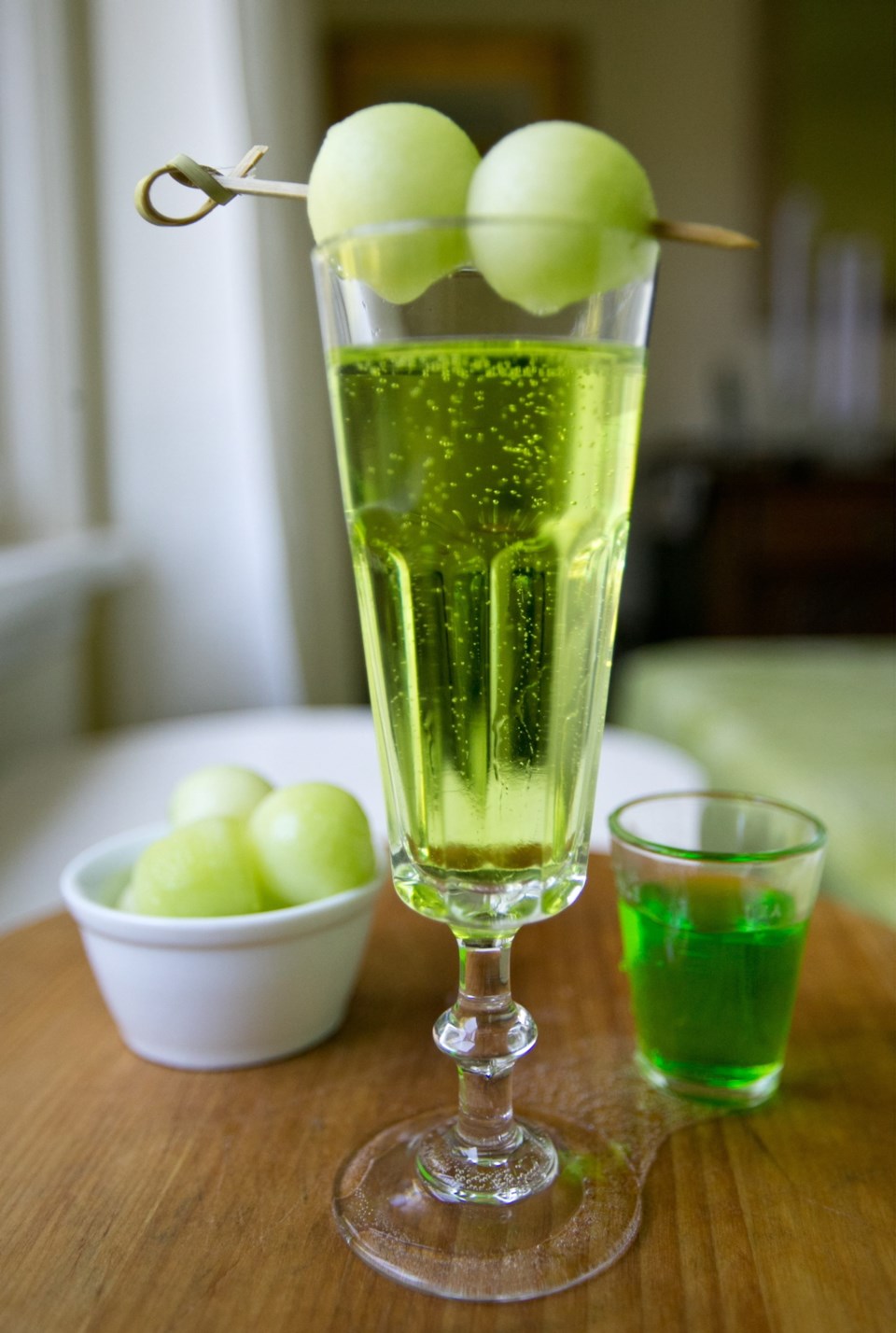 The August long weekend will soon be here and there will be weddings, family parties and gatherings of friends. Good reasons to pour a bubbly cocktail and make a toast to summer.
The August long weekend will soon be here and there will be weddings, family parties and gatherings of friends. Good reasons to pour a bubbly cocktail and make a toast to summer.
When I say bubbly cocktail, I’m, of course, talking about sparkling wine being the main ingredient in the drink. Purists would say that fine sparkling wine is already divine and should not be altered. I’m usually one of those purists, but in summer, I like to let what’s left of my hair down and stir things up. Part of the fun is deciding what type of bubbly cocktail to make.
The most classic type is a Champagne cocktail. Evidence of it being poured for a very long time can be found in old cocktail books, such as famed bartender Jerry Thomas’s How To Mix Drinks, which was published in 1862 and offers a recipe for this drink.
To make a Champagne cocktail, you drizzle and soak a sugar cube with angostura bitters. Bitters is a pungent-tasting liquor made from plant extracts. It’s used in small amounts in cocktails for flavouring, but bitters are also said to promote appetite and digestion.
Angostura bitters got their name from the town of Angostura, Venezuela, where they were first made. These days, they are made in Trinidad and Tobago and described as a botanically infused alcoholic mixture, flavoured with a secret mix of herbs and spices.
Once the sugar cube is soaked in bitters, it’s dropped into a fluted glass, topped with champagne and the drink is garnished with lemon zest. As the sugar cube sits in the bottom of the glass, it slowly dissolves and causes the wine to produce even more tiny bubbles than it normally does.
It wouldn’t be a Champagne cocktail without Champagne. But that wine is expensive and if it’s not in your budget, in the recipe below I’ve given you the option to use brut (very dry) sparkling wine. You’ll find many good-quality sparkling wines available for a half or a third of the price of Champagne, including those produced right here in B.C.
I’ve also given you the option to add a splash of cognac or brandy to the drink, which is called for in some of the Champagne cocktail recipes I’ve read.
My other two bubbly cocktail recipes are infused with the flavour of another fruit, beyond the grapes used to make the sparkling wine.
The first recipe sees kirsch (clear cherry brandy), tart cherry juice and a hint of maple syrup added to the glass before the wine is poured in. The drink is then garnished or served with some fresh cherries, creating a lovely summer drink with something to nibble on while you sip.
The other cocktail sees melon liqueur poured into the glass before being topped with sparkling wine. This drink has a stunning green colour and a fun, edible garnish of skewered melon balls.
Before making any of these cocktails, be sure the wine is well chilled. That can be achieved by refrigerating it for at least four hours before serving. If there’s no time for that, you can more quickly chill the wine by placing the unopened bottle for about 20 minutes in an ice bucket filled with an equal mixture of ice and water. It’s at the correct temperature when you put your hand on the bottle and it feels very cold, not just cool.
Classic Champagne Cocktails
The bitters-splashed sugar cube added to each glass gives the bubbly wine in this cocktail a sweet-and-sour yin and yang. I’ve given the option for this recipe to serve four to six, depending on the size of glass.
Preparation: a few minutes
Makes: four to six drinks
4 to 6 sugar cubes
12 to 18 drops Angostura bitters (see Note)
1 (750 ml bottle) brut Champagne or brut sparkling wine, well chilled
4 to 6 twist of lemon peel
Place desired amount of sugar cubes on a small plate. Add three drops of bitters to each sugar cube and let soak in. Place a cube in each glass. Divide and pour in the wine. Garnish each drink with a lemon twist and serve.
Note: Angostura bitters is sold at many liquor stores, alongside other types of bitters.
Eric’s options: Some Champagne cocktail recipes call for adding 1/2 to 1 oz of Cognac or brandy to each glass before pouring in the wine, and you can certainly do that here. Some recipes give you the option to use a twist of orange peel, instead of lemon. Lastly, there are many other types of bitters, some locally made. Feel free to experiment with another type in this drink, if desired.
B.C. Sparkling Wine Cocktails with Maple and Cherry
Maple syrup and tart cherry juice give a beguiling sweet-and-sour taste to this ruby-red, sparkling cocktail fortified with kirsch.
Preparation: a few minutes
Makes: Six (about five oz) drinks
6 tsp maple syrup
3 oz. tart cherry juice (see Note), well chilled
3 oz. kirsch (see Note)
1 (750 ml bottle) BC brut sparkling wine, well chilled
• fresh cherries, to taste
Pour 1 tsp maple syrup and a half ounce each of cherry juice and kirsch into each of six fluted glasses. Divide and pour in the wine. Garnish each drink with a fresh cherry or two
Note: Unsweetened cherry juice is sold in the bottled-juice aisle of most supermarkets. Kirsch is clear brandy made from fermented cherry juice. You’ll find it a most liquor stores.
Sparkling Melon Cocktails
This vibrant green, sparkling wine cocktail gets its colour and flavour from melon liqueur, which is sold at many liquor stores.
Preparation: 10 minutes
Makes: six cocktails
12 honeydew melon balls
6 oz. melon liqueur
1 (750 ml bottle) brut Champagne, brut sparkling wine or dry prosecco, well chilled
Place two melon balls on each of six small skewers or cocktail picks. Pour one ounce of melon liqueur into each of six fluted glasses. Divide and pour in the wine. Garnish each drink with the melon balls and serve.
Eric’s options: For a sweet-tasting accent, before pouring in the liqueur and wine, you could lightly coat the rim of each glass with granulated sugar coloured green with a little food colouring. To coat the rim of each glass, first rub and moisten each rim with a piece of honeydew melon. Then dip and twist the rim of each glass in the sugar, which you’ve spread out on a small plate. Stand each glass up and they are ready to fill.
Eric Akis is the author of The Great Rotisserie Chicken Cookbook (Appetite by Random House). His columns appear in the Life section Wednesday and Sunday.



